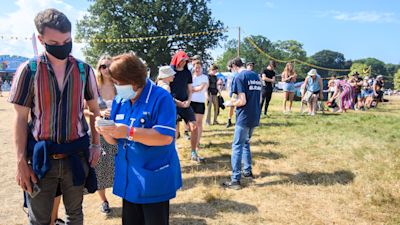Covid cases increase across most of UK as Scotland sees drop

Cases of Covid-19 have increased across the majority of the UK with Scotland the only nation to see a decline, according to newly-released data from Office of National Statistics.
The percentage of people testing positive for Covid-19 is estimated to have increased in all regions of England, apart from eastern England and south-west England where the trend is uncertain, the ONS said.
The rate of increase has, however, slowed which could be good news in the longer term.
How do levels of infection differ across England?
North-east England had the highest proportion of people of any region likely to test positive for coronavirus in the week to July 24: around one in 30.
North-west England had the second highest estimate: around one in 45.
Eastern England and south-west England had the lowest estimates: around one in 100.
Listen to the latest episode of our coronavirus podcast
How do levels of infection differ across the UK nations?
In Wales, around one in 160 people are estimated to have had Covid-19 over the same period – up from one in 210 in the previous week, and the highest level since the week to February 12.
In Northern Ireland, the latest estimate is around one in 65 people, up from one in 170 and the highest level since the week to January 30.
In more positive news, Scotland saw a decrease in people testing positive in the same period.
For Scotland, the ONS estimates that around one in 110 people had Covid-19 in the week to July 24, down from one in 80 in the previous week.
All figures are for people in private households.
The coronavirus reproduction number, or R value, in England is between 1.1 and 1.4, according to the latest Government figures.
Last week, it was between 1.2 and 1.4.
R represents the average number of people each Covid-19 positive person goes on to infect.
When the figure is above 1, an outbreak can grow exponentially but when it is below 1, it means the epidemic is shrinking.
An R number between 1.1 and 1.4 means that, on average, every 10 people infected will infect between 11 and 14 other people.
Duncan Cook, Deputy Director for the COVID-19 Infection Survey, said: "The latest ONS data suggest infections have continued to increase in England, though there are possible signs that the rate of increase may have slowed. We have also seen infections rise again in Wales and Northern Ireland over the past week, although in contrast they have decreased in Scotland.
"These new official statistics do not reflect the recent dip in the daily testing figures in England, so it’s important to understand the differences between the two sources.
"Our survey tests a large randomised sample of the population and provides an independent estimate of infections in the wider community. It’s notable that around 40% of positive tests in the ONS study are from people who show no symptoms of infection. This group is therefore less likely to show up in the daily figures.
"Together with our partners across the UK we will continue to investigate whether the current wave of infections is stabilising or not. On that it remains too early to say."